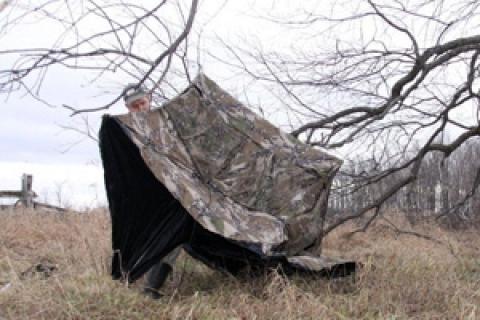
 There is no denying the popularity and effectiveness of tree stands for hunting deer, especially for bowhunting. But tree stands aren't the only way to bag a big buck, and may not even be the best way at times. Here are five reasons to stay on the ground this fall.
There is no denying the popularity and effectiveness of tree stands for hunting deer, especially for bowhunting. But tree stands aren't the only way to bag a big buck, and may not even be the best way at times. Here are five reasons to stay on the ground this fall.
- The perfect spot. Scouting will often reveal a high-percentage location to place a stand. Bowhunters particularly must choose stand locations carefully to ensure that approaching deer will allow close, clear shots. Unfortunately, there may not be any suitable trees in that spot, or any at all. However, a ground stand or blind can be located just about anywhere that provides sufficient visibility and cover to stand or sit.
- The not-so perfect spot. If you are fortunate enough to find a suitable tree in the ideal location for a tree stand, you may discover that the spot you have chosen is not so ideal after all. After setting up your tree stand and settling in for a morning or evening hunt, you may find that deer are passing by but no shots are available due to heavy brush. Or perhaps the deer you are seeing are all out of range. Or, worst of all, you aren't seeing any deer at all. If you choose to move your tree stand, you are again faced with the same problems as when first placing it. But relocating your ground stand quickly and quietly is as simple as getting up and moving to a new spot, without causing any disturbance.
- Position shifting. When hunting from a tree stand, if you hear a deer approaching from behind, getting a shot may be next to impossible. When hunting from a ground stand, however, solving that problem is as simple as standing up (if you are sitting) and stepping out from behind the tree. Similarly, when situated on the ground overlooking more than one field, valley or tree line, you may find that just a slight shift of a few feet either way can provide a completely different view and allow you to cover a whole other area. If you get only a glimpse of a buck as it slips through the brush, or spot a deer that is too far for a shot, you can even attempt to follow or stalk it, something that's not so easy when sitting up in a tree.
- Cover. Whether on the ground or in a tree, sufficient cover is required to conceal any small movements you will make while on stand. Unfortunately, many trees are too bare, especially late in the fall or early winter, to offer such concealment. Contrary to popular belief, deer do look up, and a tree stand silhouetted up a naked tree is just too noticeable and unnatural-looking to wary deer. Natural cover is usually thicker at ground level, normally providing all the concealment necessary. If not, portable blinds are the ticket, or fairly elaborate stands can be constructed from natural cover with little effort.
- Shelter. If you have spent much time high up in a tree during bitter cold, high wind, driving rain or snow, or searing heat, you know that it's not a very pleasant experience. The reality is that most trees simply leave you too exposed to extreme weather. At ground level, however, it's a different story. The forest's canopy offers much better protection from the elements at the base of the tree than further up. Cedars and other conifers, in particular, can offer a surprising amount of shelter, helping to keep you warm, dry, shaded and comfortable. Of course, an enclosed portable blind is even better.
In a future blog, we'll talk about points such as comfort, safety and ease of shooting.
Good hunting.
- 2573 views

